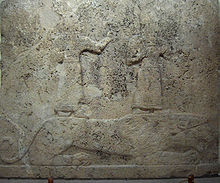Sun god of the sky
The sun god of the sky ( Heth. Nepišaš Ištanu) is a Hittite sun deity . Next to the sun goddess of Arinna, he is the second sun deity worshiped by the Hittites . The sun god of the sky was equated with the Hurrian sun god Šimige .
The sun god of the sky in the Hittite empire

The sun god of the sky served since the time of the Hittite king Tudḫaliya II as the protective deity of the great king , indicated by a winged sun disk on the king's seal , and finally became god of kingship par excellence . Since the Great King Šuppiluliuma I , perhaps earlier, the sun god of the sky has played an important role as the supreme oath god of the state treaties .
Based on the Mesopotamian sun god Šamaš , the sun god of heaven also gained increased importance as the god of law , justice and truth .
Other sun gods of ancient Anatolia
Tiwaz
Tiwad, also Tiwat, Tiwata or Tiwaz, is the sun god of the Luwians . Unlike the Mesopotamian Šamaš, he had no connection to the underworld . This aspect of the sun was embodied in the Luwian belief by the sun goddess of the earth .
In the city of Tauriša Tiwad formed a triad with the goddess Kamrušepa and their son, a patron god ( Sumerogram LAMMA) with the Luwian nickname wašḫazza- ("consecrated, holy").
Tiwad was also worshiped in the neo-Hittite states of the Luwian language of the Iron Age .
Tiyaz
Tiyaz, also Tiyad, is the sun god worshiped by the Palaer . He was referred to as the king's father and mother.
literature
- Piotr Taracha : Religions of Second Millennium Anatolia . Harrassowitz, Wiesbaden 2009, ISBN 978-3-447-05885-8 .
- Calvert Watkins: The Golden Bowl: Thoughts on the New Sappho and its Asianic Background. In: Classical Antiquity. Volume 26, 2007, pp. 305-324.
- Volkert Haas , Heidemarie Koch : Religions of the ancient Orient: Hittites and Iran . Vandenhoeck & Ruprecht, Göttingen 2011, ISBN 978-3-525-51695-9 .
- Maciej Popko : Peoples and Languages of Old Anatolia . Harrassowitz, Wiesbaden 2008, ISBN 978-3-447-05708-0 .
Remarks
- ^ Calvert Watkins: The Golden Bowl: Thoughts on the New Sappho and its Asianic Background. In: Classical Antiquity. Volume 26, 2007, p. 309.
- ^ Piotr Taracha: Religions of Second Millennium Anatolia . Wiesbaden 2009, p. 90 f.
- ^ Piotr Taracha: Religions of Second Millennium Anatolia . Wiesbaden 2009, p. 127.
- ^ Piotr Taracha: Religions of Second Millennium Anatolia . Wiesbaden 2009, p. 89.
- ^ Piotr Taracha: Religions of Second Millennium Anatolia . Wiesbaden 2009, p. 90.
- ^ Piotr Taracha: Religions of Second Millennium Anatolia . Wiesbaden 2009, p. 88.
- ^ Piotr Taracha: Religions of Second Millennium Anatolia . Wiesbaden 2009, p. 89.
- ↑ Volkert Haas, Heidemarie Koch: Religions of the ancient Orient: Hittites and Iran . Göttingen 2011, p. 226.
- ^ Maciej Popko: Peoples and Languages of Old Anatolia . Wiesbaden 2008, p. 29.
- ^ Calvert Watkins: The Golden Bowl: Thoughts on the New Sappho and its Asianic Background. In: Classical Antiquity. Volume 26, 2007, p. 309.
- ^ Piotr Taracha: Religions of Second Millennium Anatolia . Wiesbaden 2009, p. 107.
- ^ Piotr Taracha: Religions of Second Millennium Anatolia . Wiesbaden 2009, p. 109.
- ^ Piotr Taracha: Religions of Second Millennium Anatolia . Wiesbaden 2009, p. 100.
- ^ Calvert Watkins: The Golden Bowl: Thoughts on the New Sappho and its Asianic Background. In: Classical Antiquity. Volume 26, 2007, p. 321 f.
- ^ Piotr Taracha: Religions of Second Millennium Anatolia . Wiesbaden 2009, p. 58.
- ^ Piotr Taracha: Religions of Second Millennium Anatolia . Wiesbaden 2009, p. 88.
